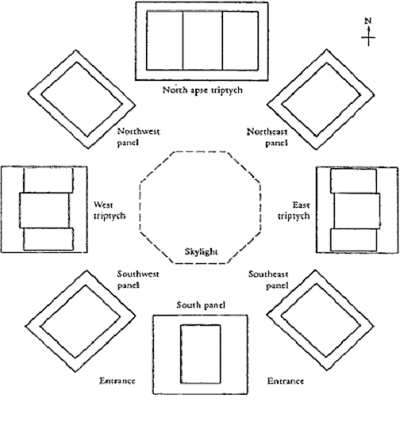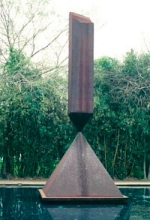
Religiöse Räume |
Ein Raum für Religiöses
Die Mark-Rothko-Kapelle in HoustonAndreas Mertin Wenn es überhaupt einen Raum gibt, der als wegweisendes Vorbild für religiöse und vor allem interreligiöse Nutzung im Kontext künstlerischer Arbeit dienen kann, dann ist es sicher die Mark-Rothko-Kapelle in Houston/Texas. Die Rothko-Kapelle gehört zum Campus der Universität St. Thomas, die von dem Architekten Philip Johnson entworfen wurde [Eine andere, freilich erst viel später entstandene Kapelle von Johnson auf dem gleichen Campus mit postmodern-dekonstruktiven Ansätzen ist St. Basil]. Ursprünglich als katholische Kapelle für die Universität geplant, ist schließlich eine nicht nur interkonfessionelle, sondern interreligiöse Kapelle entstanden. "The Rothko Chapel, founded by John and Dominique de Menil, was dedicated in 1971 as an intimate sanctuary available to people of every belief. A modern meditative environment inspired by the mural canvasses of American abstract expressionist Mark Rothko, the Chapel welcomes thousands of visitors each year, people of every faith and from all parts of the world. The Chapel has two vocations: contemplation and action. It is a place alive with religious ceremonies of all faiths, and where the experience and understanding of all traditions are encouraged and made available. Action takes the form of supporting human rights, and thus the Chapel has become a rallying place for all people concerned with peace, freedom, and social justice throughout the world." (Website der Kapelle) Die Auftraggeber John und Dominique Menil sind berühmte Kunstsammler, deren Sammlung über 15.000 Werke umfasst. Sie hatten engen Kontakt mit dem Dominikanerpater Couturier, mit dem beide 1952 die Kirche von Ronchamp und die Rosenkapelle in Vence besuchten, die ohne Zweifel die Entscheidung, in Houston eine derartige Kapelle zu bauen, beeinflussten.
Der Raum wird von allen Besuchern übereinstimmend als besonders intensiver Wahrnehmungs- und Meditationsraum beschrieben. „Mark Rothko, one of the most influential American artists of the mid-century was commissioned by the de Menils and given the opportunity to shape and control a total environment to encompass a group of fourteen paintings he especially created for this meditative space. He worked closely with the original architect Philip Johnson on the plans, then with Howard Barnstone and Eugene Aubry who completed the building.
As an institution, The Rothko Chapel functions as chapel, a museum and a forum. It is a place where religion, art and architecture intermingle. The Rothko Chapel is free, open to the public, and accessible to the physically challenged every day of the year. It has become a pilgrimage stop for thousands of visitors who are drawn by its importance both as an artistic masterpiece and as an ecumenical gathering place for people of all religious beliefs.“ [Website der Kapelle] Und tatsächlich hat sich durch die Kraft der Bilder, durch die verdichtete Atmosphäre des Raumes, aber auch durch den Verzicht auf eine ausgrenzende religiöse Symbolik zugunsten einer ästhetisch-spirituellen Einladung hier ein Ort etabliert, der – wie ein Blick auf das Programm zeigt – Mitglieder und Vertreter nahezu aller Religionen anspricht. |
|
Artikelnachweis: https://www.theomag.de/54/am247.htm
|
 Der von Johnson ursprünglich quadratisch geplante Bau wurde auf Intervention von Rothko oktogonal umgeplant. In diese oktogonale Grundstruktur hat Rothko 14 monochrome Arbeiten eingefügt, die den gesamten Raum umgeben.
Der von Johnson ursprünglich quadratisch geplante Bau wurde auf Intervention von Rothko oktogonal umgeplant. In diese oktogonale Grundstruktur hat Rothko 14 monochrome Arbeiten eingefügt, die den gesamten Raum umgeben. The Rothko Chapel and Barnett Newman’s sculpture: “The Broken Obelisk” facing the Chapel and dedicated to Dr. Martin Luther King, Jr., have achieved world recognition as examples of the greatest artistic achievements of the second half of the twentieth century.
The Rothko Chapel and Barnett Newman’s sculpture: “The Broken Obelisk” facing the Chapel and dedicated to Dr. Martin Luther King, Jr., have achieved world recognition as examples of the greatest artistic achievements of the second half of the twentieth century.